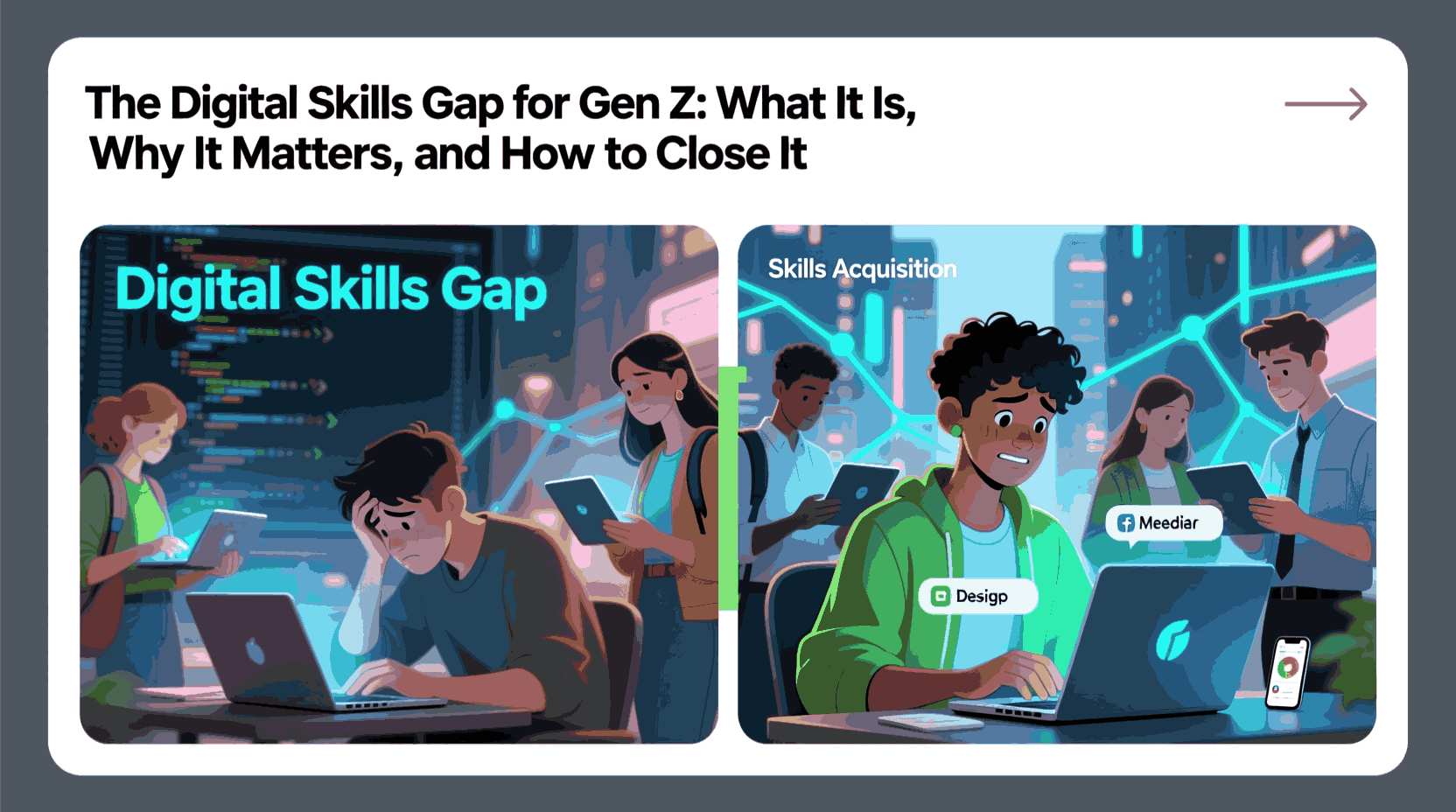Introduction: The Paradox of the “Digital Native”
They’ve never known life without Wi-Fi, yet only 32 % of Gen Z feel confident they have the digital skills employers actually want
By 2025 Gen Z will comprise 27 % of the global workforce, but managers already report that 39 % of them lack the tech skills required for entry-level roles
Welcome to the Gen Z digital skills gap—a mis-match between “life on social media” and “life on the job” that threatens productivity, innovation and young careers alike.
1. What Exactly Is the Digital Skills Gap?
| Everyday Digital Fluency | Workplace Digital Readiness |
|---|---|
| Scrolling TikTok | Configuring CRM dashboards |
| Face-timing friends | Running data-driven reports |
| Online shopping | Automating marketing funnels |
| Gaming & streaming | Writing secure code |
The digital skills gap is the space between comfortable consumer tech use and the enterprise-grade, data-secure, automation-heavy stack modern companies run on.
92 % of jobs now require digital skills, yet ⅓ of workers don’t have them—and Gen Z is surprisingly over-represented in that third.
2. Key Stats That Show the Size of the Problem
- 48 % of employers believe graduates leave university without advanced digital skills.
- Only 20 % of Gen Z feel competent in coding; 17 % in AI; 18 % in cybersecurity.
- 36 % of hiring managers avoid Gen Z candidates, citing “lack of experience”.
- 65 % of employers have fired a Gen Z hire within one week
3. Why the Gap Exists: Four Root Causes
3.1 Pandemic-Disrupted Education
Lockdowns forced remote lectures, cancelled labs and no internships, stripping out the hands-on practice where hard skills are forged
3.2 “Digital Native” Myth
Growing up with smartphones ≠ understanding data pipelines, cloud security or API integrations. Consumer interfaces hide the complexity that businesses operate on
3.3 Curriculum Lag
Most K-12 and university syllabi teach office productivity tools at best, leaving emerging tech (AI, RPA, low-code, analytics) to extracurricular self-study
3.4 Remote-First Work
Gen Z’s first jobs are often fully remote, reducing organic mentoring, “over-the-shoulder” learning and real-time feedback loops older generations enjoyed
4. The Fallout: Who Pays the Price?
For Gen Z
- Slower hiring, lower starting salaries, limited promotion velocity.
- 70 % expect promotion within 18 months, but without skills proof, aspirations stall .
For Employers
- 76 % of businesses say the gap hits profitability via lower productivity, slower innovation and higher onboarding costs.
- Turnover risk: unskilled and un-mentored Gen Z staff job-hop faster, draining recruitment budgets.
For the Economy
A shortage of digitally fluent talent could bottleneck digital transformation across health, finance and green-tech sectors precisely when 91 % of jobs are forecast to require tech skills by 2030
5. The Soft-Skills Multiplier Effect
Don’t file this story under “hard tech only”.
43 % of managers also label Gen Z “unskilled” in communication, resilience and problem-solving
Why it matters: soft skills accelerate digital upskilling—asking the right question, giving/receiving feedback, storytelling with data.
Without them, even the best coding boot-camp ROI crashes.
6. How to Close the Gap: 7 Actionable Plays
6.1 Micro-Credential & Certificate Stacking
Offer industry-recognized nano-degrees in Power BI, SQL, Python, cybersecurity and low-code automation.
Badging systems let Gen Z “stack” proof of mastery faster than a four-year degree.
6.2 Learning in the Flow of Work
Embed 5-minute tutorial pop-ups inside Slack, Jira or Salesforce so employees solve problems at the moment of need instead of waiting for a quarterly course.
6.3 Reverse Mentoring + Traditional Mentoring
Pair Gen Z (social media, design thinking) with senior execs (industry context) for two-way knowledge flows, boosting engagement & retention simultaneously.
6.4 Project-Based Cohorts
Move from webinar-style to sprint-based learning: small cross-functional teams build a real dashboard, chatbot or RPA bot in 4–6 weeks with coach checkpoints.
6.5 Soft-Skill Sprints
Run improv workshops, storytelling labs, OKR negotiation drills—measured via rubrics and peer feedback to make “soft” skills visible and improvable.
6.6 Funding & Apprenticeships
Leverage new government subsidies (e.g., U.S. Digital Skills Act 2024) to co-fund boot-camps or registered apprenticeships, reducing per-employee training cost by up to 50 %
6.7 Hire for Potential, Test for Skills
Swap résumé screening for skills assessments (e.g., GitHub commits, no-code challenges, data-cleaning timed tests) to surface hidden talent overlooked by pedigree filters.
7. Quick-Start Checklist for Employers
| Step | Action Item | Owner | Timeline |
|---|---|---|---|
| 1 | Audit current digital task inventory | Ops Lead | Week 1 |
| 2 | Map skill gaps vs. Gen Z competencies | HR + IT | Week 2 |
| 3 | Select micro-credential partner (Coursera, Pluralsight, QA, FDM) | L&D | Week 3 |
| 4 | Launch pilot cohort (10–15 Gen Z staff) | Line Managers | Month 1 |
| 5 | Track KPI triad: speed-to-productivity, error rate, NPS | Data Analyst | Monthly |
| 6 | Iterate & scale enterprise-wide | Exec Sponsor | Quarter 2 |
8. The Way Forward: A Shared Responsibility
Closing the Gen Z digital skills gap isn’t a “youth problem”; it’s a business continuity problem.
Educators must modernize curricula, governments must fund reskilling, and employers must provide safe practice grounds.
Gen Z? They’re ready: 73 % believe AI skills are crucial and want employers to train them
Give them real challenges, tight feedback loops and visible career paths, and the “digital native” label will finally match digital mastery.
Key Takeaways
- Consumer tech fluency ≠ enterprise digital readiness.
- Pandemic-era education & remote work widened the hard- and soft-skills gap.
- 92 % of jobs need digital skills, but only 32 % of Gen Z feel equipped.
- Mentorship, micro-credentials and project-based learning are the fastest levers to close the divide.
- Companies that act now gain first-mover advantage on innovation, retention and profitability.
